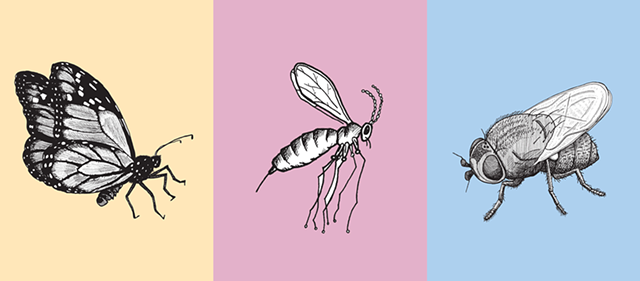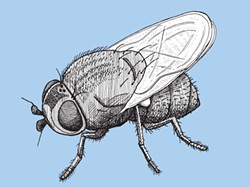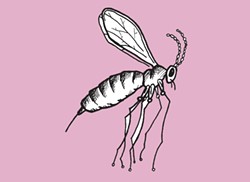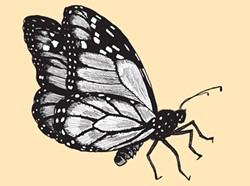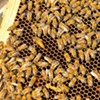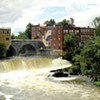Published July 29, 2015 at 10:00 a.m. | Updated July 30, 2015 at 10:41 a.m.
The physical size of an organism can be inversely proportional to its impact on the world. Homo sapiens is an outlier; most of the creatures that create global events are microscopic: viruses, bacteria, fungi. Such infinitesimal life forms are, however, outside the scope of Seven Days' annual Animal Issue.
Insects are not. Though small, bugs have a big profile in the natural world. Here we consider a few that are locally important for being destructive or fragile harbingers of ecological distress. We can learn a lot from these little guys.
Hemlock Woolly Adelgids and Silver Flies
The waste product of the millimeter-long Hemlock woolly adelgid looks like spun cotton, and it's super-sticky — all the better for the bug to catch a ride on a passing bird. Cocooned in this fibrous material and clustered along the needles of a hemlock tree, the minute insects literally suck the vital essence from the tree.
HWA, as entomologists call it, is a native of Japan and was first spotted in the U.S. in the 1960s. The bug infests hemlock and other coniferous trees from Georgia to Ontario; over time, it can decimate entire forests. The injection of pesticides into infected trees can kill the bugs, but large-scale application is impractical and costly, and the effects last no longer than three years. Moreover, the bugs may develop resistance, so this year's pesticide may not be effective next year.
Kimberly Wallin is a research associate professor and director of the graduate program at the University of Vermont's Rubenstein School of Environment and Natural Resources. She's working on a project that shows promise for controlling HWA and saving the hemlock: introducing predatory insects called silver flies, which feast on adelgids. Wallin is working on a plan to transport these flies to the areas hardest hit by HWA.
She knows that some past efforts to use one nonnative species to control another have gone haywire (look up the Australian cane toad), but she and her colleagues have scrupulously studied and field-tested Leucopis piniperda and Leucopis argenticollis. The results have been encouraging.
"We know the hemlock trees are dying, and we know that they will be removed from the ecosystem," Wallin says. "Are there risks in introducing a predator into the environment? Of course there are. Do we know that [silver flies] feed on adelgids? We do."
Hemlocks, says Wallin, are a "keystone species," meaning that their presence is central to their ecosystems. "When they're removed, the soil pH changes," she explains. "They often grow in riparian areas, so the stream chemistry changes. There's this whole trophic cascade when they're removed from an ecosystem. It's pretty devastating."
This is a regional issue, Wallin stresses: Damage inflicted by HWA has been found on trees in southern Vermont, and the researcher is still assessing how much the insect threatens other Vermont habitats.
Working with Darrell Ross, a professor of forest entomology at Oregon State University, Wallin has designed an experiment in which infested hemlock branches are encased in a sleeve that contains a population of adult silver flies. Results collected this summer show that the silver flies not only survive in this mini-ecosystem but multiply. More importantly, they've been chowing down on the adelgids. Wallin is encouraged by the rate at which the experiment has yielded such "really, really promising" results.
The next step: scaling up the project. Through the U.S. Department of Agriculture's HWA initiative, the study has secured two more years of funding to combat what the department calls "the single greatest threat to the health and sustainability of hemlock."
Fortunately for the hemlocks, it's a bug-eat-bug world out there.
Swede Midges
The tiny swede midge was first found in Vermont in 2007 on a broccoli crop at Burlington's Intervale Community Farm, says farm manager Andy Jones. "At first, I thought it was heat damage," he says, "but when we started to see it in late August and September ... that's when things started to get puzzling. You'd look down at the broccoli plants, and there was just no head in the middle."
At only a couple of translucent millimeters long, the swede midge is easy to overlook, but that doesn't stop it from wreaking hellacious, costly havoc on plants of the Brassica family, a large group that includes broccoli, kale, cabbage and Brussels sprouts.
After years of trying to draw attention to the pest, Jones connected with Yolanda Chen, assistant professor of agroecology, entomology and biological control at UVM's College of Agriculture and Life Sciences. She is now leading the search for ways to control swede midge, which has destroyed entire Brassica crops on commercial farms in New York and southern Canada.
Swede midge — which gets its name from another term for rutabaga, one of the plants it enjoys eating — harms Brassicas by nestling itself into the folds of a plant's buds. The larvae devour the food-bearing portions of the plants and, in the process, produce galls, or tumorlike outgrowths. When this happens, the plants "freak out," as Chen puts it. Their edible parts become stunted, scarred or deformed, often spectacularly. When the midges mature, they lay eggs in a nearby plant, and the cycle begins again.
The midges are so small and so well ensconced in a plant's buds that even the powerful pesticides called neonicotinoids (the same ones partly responsible for colony collapse disorder in honeybees) are not necessarily effective against them. Even if pesticides could kill these pests, farmers committed to organics would be out of luck. That's where Chen's research comes in. At UVM's Insect Agroecology and Evolution Lab, she and her graduate students are exploring several natural methods of midge control.
When infested, many plants ramp up the production of acidic compounds as a means of natural defense, and Chen is exploring the application of such acids. She's also investigating a strategy called "intercropping," in which plants only distantly related to Brassicas are planted among them. In this way, she hopes, the odors of the tasty Brassicas may be masked by commingling other species with them. In experimental plots in front of James M. Jeffords Hall, Chen and her students have interspersed several promisingly midge-repellent botanicals among their Brassicas. The project is ongoing.
With a recent $250,000 grant from the USDA, Chen is also exploring the potential of using huge amounts of midge pheromones to mess with the insects' mating cycle. The idea is to release such massive amounts of synthetic female swede midge pheromone that the males would be overwhelmed and unable to find mates. If it works: no more midge babies.
For now, Jones and other farmers are doing what they can to mitigate swede midge infestations. That means growing one season's Brassicas as far as possible from the site of the previous year's planting, and using fine netting called a floating row cover wherever possible. But, as Jones puts it, "I don't think we're that close to a magical solution just yet."
Monarch Butterflies
Recent news about the striking, iconic monarch butterfly has not been good. The Xerces Society, a nonprofit organization devoted to the conservation of invertebrates, announced in March that North American monarchs are "vulnerable to extinction." Annual census data show that the monarch population has collapsed in the last 20 years from about one billion to 56.5 million — a decline of more than 80 percent.
One likely culprit: a dramatic, pesticide-induced die-off of milkweed, a plant essential to the insect's survival. Monarchs lay their eggs exclusively on milkweed leaves, which provide food for its larvae. Many of the food crops that grow in proximity to milkweed have been genetically modified to resist pesticides, but milkweed has no such resistance. Less milkweed means less food for monarchs, which could result in an even greater decline in their numbers.
Mark Ferguson, a zoologist at the Vermont Fish & Wildlife Department, says that local numbers of the insects have been "really low" for the last three years. He's quick to add, though, that concerned Vermonters may be able to help the butterfly. Simply allowing milkweed plants to grow could make a difference in the insect's survival rate.
The scale of even the largest agricultural operations in Vermont is far smaller than those in the factory farms of the Midwest, where pesticide application is standard practice. "What we consider a big [agricultural] field is actually a patchwork," says Ferguson. "We still have open fields that are filled with milkweed." Even a smattering of backyard plants could make a difference, he says.
Vermont is near the northern edge of the monarch's annual migration, which commences in Mexico, spreads across the lower 48 and extends into southern Canada. While butterflies born in the north make the entire journey to Mexico in one go, the return pilgrimage cannot be accomplished by a single generation. It is often the great-grandchildren of the initial migrants that reach their eventual destinations in late summer. Common milkweed, which grows in all 48 states, allows the insects to spawn, re-spawn and feed along the way.
Vermont is effectively the northernmost refueling station for many monarchs before they set off on their return flight. For this reason, Ferguson says, a local abundance of milkweed could make a difference in the overall health of the species. "It's the idea of acting locally to make a change," he says. "We're providing that late-season oasis so that, when they get here, they have food to eat and they're able to reproduce ... before they make that big southern migration again."
Adult monarchs feed on nectar from a variety of plants, so Ferguson also advocates leaving untouched any patches of wildflowers.
Hacking down the weeds on one's property, Ferguson says, is one way for humans to exert a little control over their home environments. This could be one reason, though, to let nature encroach a little more than usual.
The original print version of this article was headlined "Bugging Out"
More By This Author
Speaking of...
-

A Burlington Celebration of Nature Helps Citizen Scientists Connect With — and Count — the City's Nonhuman Residents
Apr 24, 2024 -

A Middlebury College Researcher Sheds New Light on Familiar Summer Insects
Aug 10, 2022 -

The Many-Splendored Moths of Montpelier
Aug 10, 2022 -

Vermont Mealworm Farm Fuels Plants, Pets and People
Aug 10, 2021 -

Delivering Eggs by Donkey in Montpelier
Aug 15, 2017 - More »
Comments
Comments are closed.
From 2014-2020, Seven Days allowed readers to comment on all stories posted on our website. While we've appreciated the suggestions and insights, right now Seven Days is prioritizing our core mission — producing high-quality, responsible local journalism — over moderating online debates between readers.
To criticize, correct or praise our reporting, please send us a letter to the editor or send us a tip. We’ll check it out and report the results.
Online comments may return when we have better tech tools for managing them. Thanks for reading.



































